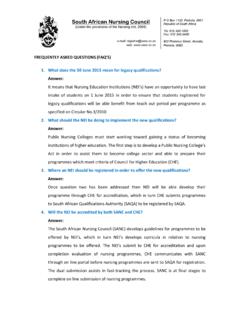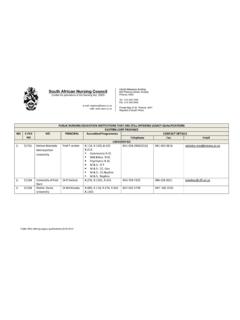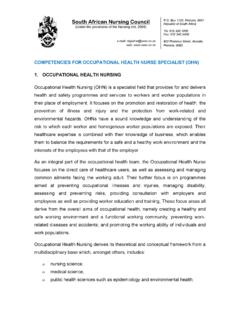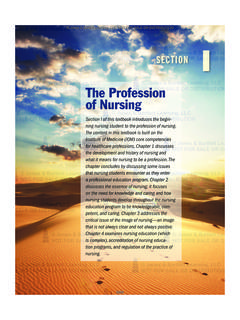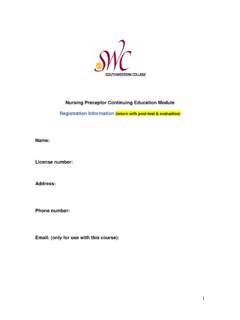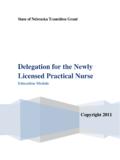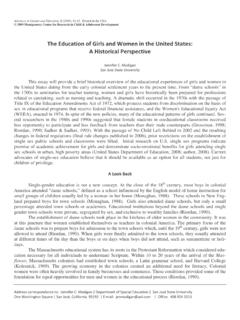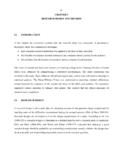Transcription of South African Nursing Council
1 South African Nursing Council (Under the provisions of the Nursing Act, 2005) e-mail: web: P O Box 1123, Pretoria, 0001 Republic of South Africa Tel: 012 420-1000 Fax: 012 343-5400 602 Pretorius Street, Arcadia, Pretoria, 0083 Nursing EDUCATION AND TRAINING STANDARDS INTRODUCTION The SANC shall, by administrative rules and regulation, set standards for the establishment and outcomes of Nursing education and training programmes, including clinical learning programmes and approve such programmes that meet the requirements of the Nursing Act (No. 33 of 2005). As the regulator of nurses and midwives in South Africa, the mission of the SANC is to: Safeguard the health and wellbeing of the public, Maintain a register of nurses and midwives: Set and maintain standards of education, training and practice Ensure that nurses and midwives keep their skills and knowledge up to date, and uphold the standards of their professional code Ensure that nurse and midwives are safe to practice by setting legal ethical framework for their practice.
2 Provide mandatory guidance and additional advice to people designing and developing education programmes 2 BACKGROUND INFORMATION AND CONTEXT In 2001 the World Health Assembly (WHA) supported the call to strengthen the Nursing and midwifery professions by passing a resolution , validating WHO s commitment to the scaling up of the health professions. The need for global standards has arisen for several reasons: the increasing complexities in health care provision, the increasing number of health professionals at different levels and the need to assure more equitable access to health care.
3 The global standards for the initial education of professional nurses and midwives are intended to serve as a benchmark for moving education and learning systems forward to produce a common competency based outcome in an age of increasing globalization. Nursing education and training across South Africa is responding to changing needs, developments, priorities and expectations in health and healthcare. Nurses who acquire the knowledge, skills and behaviors that meet our standards will be equipped to meet these present and future challenges, improve health and wellbeing and drive up standards and quality, working in a range of roles including practitioner, educator, leader and researcher.
4 As autonomous practitioners, nurses will provide essential care of a very high standard and provide complex care using the best available evidence and technology where appropriate. Our standards aim to enable nurses to give and support high quality care in rapidly changing environment. The standards reflect how future services are likely to be delivered, acknowledge National Health Priorities, Re-engineering Primary Health Care and National Health Insurance. Nurses and midwives must be able to develop practice, and promote and sustain change. 3 GLOSSARY: Accreditation : A process of review and approval by which an institution, programme or specific service is granted a time-limited recognition of having met certain established standards.
5 Assessment : A systematic process for collecting qualitative and quantitative data to measure, evaluate or appraise performance against specified outcomes or competencies. Clinical learning: Part of the educational process that takes place in any practice setting in hospital or community Code of ethics: The rules or standards governing the conduct of a person or the conduct of the members of a profession. Competence : The combination of knowledge, psychomotor, communication and decision-making skills that enable an individual to perform a specific task to a defined level of proficiency. Competency based education: Teaching, learning and assessment activities that are sufficient to enable students to acquire and demonstrate a predetermined set of competencies as the outcome of learning.
6 Curriculum : A systematic process that defines the theoretical and practical content of an education programme and its teaching and evaluation methods. Determinants of health: The range of personal social economic and environmental factors which determine the health status of individuals, groups and population. Domain: Is a sphere or field of activity concern or function. 4 Graduate: One who has received an academic and professional qualification in an institution higher of learning Practical experience: Student time in Nursing and midwifery practice settings for acquiring and applying knowledge, skills and behaviours and demonstrating competency in the practice of Nursing and midwifery.
7 Protection of the public: To ensure the safety of the public through its regulatory mechanisms. Quality improvement: An ongoing process for determining the effectiveness of actions and making needed improvements. Recognition of prior learning: Procedures or processes whereby students are assessed and may be given recognition for knowledge and skill acquired through past learning and experience relevant to current programme of learning Standard: Statement of a defined level of quality that articulates the expectation of initial Nursing and midwifery programme. Work integrated learning: A component of a learning programme that focuses on the application of theory in an authentic, work-based context.
8 It addresses specific competences identified for the acquisition of a qualification. The summary below highlights the structure and format of the Nursing education and training standards developed: 5 DOMAINS SUB-DOMAINS STANDARDS Criteria Sources of Evidence 1. PROGRAMME GRADUATES OUTCOMES Graduates adhere to professional values, norms and standards Graduates reflect established competencies in Nursing and midwifery practice Duration & structure of course facilitates achievement of competencies Total clinical practice hours are adequate for graduates to achieve competency Clinical practice learning commences from the first year of training Theory precedes practica Practica hours are not less than 60% of the total duration of course Minimum of 8 weeks uninterrupted practica at end of course to allow for transition into workplace.
9 Course book with details of course Copy of full course outline Curriculum map/ grid Description of clinical experience Outline of the total clinical experience Duration and location of placements 6 DOMAINS SUB-DOMAINS STANDARDS Criteria Sources of Evidence Midwifery component must allow for continuity of care and facilitate acquisition of midwifery competencies 7 DOMAINS SUB-DOMAINS STANDARDS Criteria Sources of Evidence Midwifery component allows for integration of theory and practice with a minimum of 50% theory and 50% practica Structure of course facilitates extended period of placement in the clinical area toward the end the component to allow for consolidation of competencies 8 DOMAINS SUB-DOMAINS STANDARDS Criteria Sources of Evidence Graduates show sound understanding of the determinants of health Curriculum is mapped against SANC competency framework Programme outline clearly sets out plan for opportunities for the graduate is to obtain competence Selection organization and sequencing of curriculum allows graduate to attain competencies Organization of the learning programme focuses on
10 Nursing and current Nursing issues with focus on health promotion, disease prevention and care of individuals, families and groups across the life span Table of competencies matched against curriculum content. Course content with the rationale Description of the content indicating reference to relevant current reports. Include legal and professional reports Focus on evidence based content Benchmark against 9 DOMAINS SUB-DOMAINS STANDARDS Criteria Sources of Evidence Nursing practice is inclusive of promotion and maintenance of health and prevention of illness Learning opportunities must allow graduate to assess , plan, implement and evaluate care according to clients needs Learning records provide evidence of learning taking place within the multidisciplinary team with opportunities for delegation, supervision.


